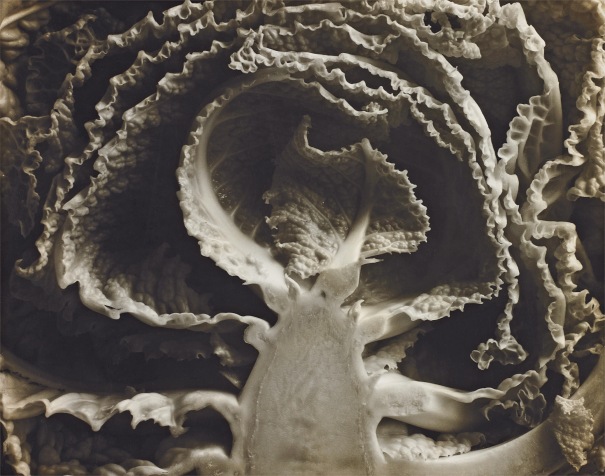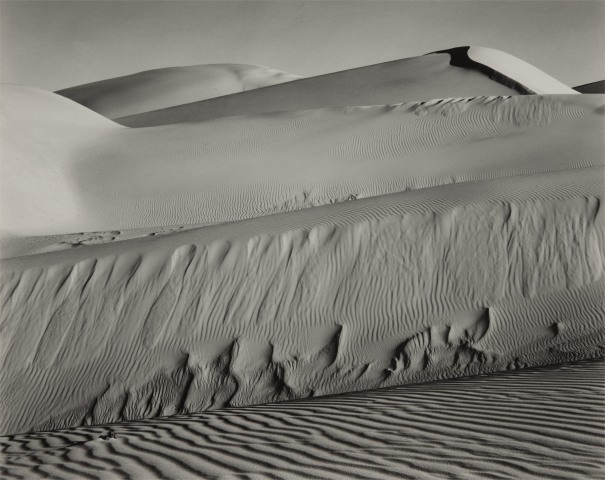IMPORTANT PHOTOGRAPHS FROM THE COLLECTION OF DR. ANTHONY TERRANA Edward Weston Shells 1927 Gelatin silver print, printed before 1947. 7 1/2 x 9 1/4 in. (19.1 x 23.5 cm) Initialed and dated in pencil on the mount; signed, titled and dated in pencil on the reverse of the mount.
Provenance Howard Greenberg Gallery, New York Fraenkel Gallery, San Francisco Weston Gallery, Carmel Robert Klein Gallery, Boston Literature Armitage, Fifty Photographs, pl. 28 Conger, Edward Weston Photographs from the Collection of the Center for Creative Photography, cover and fig. 549 Mora, Edward Weston Forms of Passion, p. 152 Newhall, Supreme Instants: The Photography of Edward Weston pl. 28 Catalogue Essay On March 20, 1927, Modernist legend Edward Weston noted in his personal Daybook: “The shells I photographed were so marvelous one could not do other than something of interest.” Indeed, the 14 negatives of the chambered nautilus recorded by Weston evoked an array of reactions from some of the notable names in Modernism. René d’Harnoncourt, who later became the director of The Museum of Modern Art, described the shells as “erotic”, while Tina Modotti a photographer and Weston’s former lover claimed that the shells “made me think of lilies and embryos.” And perhaps most abstractly, Weston’s friend and fellow artist Jean Charlot referenced the shells as inspiration in perceiving the worlds as “known elements in unknown quantities.” The power of the shells, it appears, lay in their ability to simultaneously occupy a dual consciousness: at once soigné nautical remnants as well as sensual biomorphic emblems. Weston’s path to Modernist photography, which championed the medium’s strength: clarity, tonality and linearity, was typifed by a number of twists and turns, including a Pictorialist period that stretched for seven years, starting in 1913. Pictorialism was the dominant aesthetic approach among photographers at the turn of the last century. Propelling Pictorialism to the foreground was the perception that in order to be considered of artistic merit, a photograph was to imitate the feld of painting. Given the heavy Impressionist and Post-Impressionist haze that shrouded the zeitgeist at the time, Weston adopted a soft focus and effusive lighting in an effort “to be artistic”, he later stated. However, by the early 1920s, Weston began adopting a more Modernist approach to his work, using the distinguishing features of the medium to his advantage. From 1923 to the very end of 1926 Weston primarily resided in Mexico, where he continued fostering his Modernist approach to the medium, photographing cropped architectural details, folk-art crafts and religious relics. His images from that period are distinctly crisp and simple, accentuating the formalist qualities of the subjects. It was during his Mexican stay that Weston began abstracting a familiar subject—a human body—to remarkable efects. The nude studies of Anita Brenner Miriam Lerner and his son Neil reflect Weston’s progressive wish to think outside the immediate parameters of the genre and present the human body in a jarringly unfamiliar manner. This approach was further developed upon Weston’s return to California, where he continuously abstracted the human form. In February of 1927, Weston met the Canadian painter Henrietta Shore. While viewing a series of Weston’s nudes, the two likely discussed Shore’s favored subject matter of the chambered nautilus, providing inspiration for a transition within Weston’s own work. On April 1, Weston writes in his Daybook: “I am stimulated to work with the nude body, because of the infinite combinations of lines which are presented with every move. And now after seeing the shells of Henrietta Shore, a new field has been presented.” For the next few months, Weston fluidly experimented with shells and nudes. In fact, on the day that Weston took the image Shells, seen in the present lot, he discussed his activities: “One of these two new shells when stood on end, is like a magnolia blossom unfolding. The difficulty has been to make it balance on end and not cut of that important end, nor show an irrelevant base. I may have solved the problem by using another shell for the chalice, but I had the Devil’s own time trying to balance
IMPORTANT PHOTOGRAPHS FROM THE COLLECTION OF DR. ANTHONY TERRANA Edward Weston Shells 1927 Gelatin silver print, printed before 1947. 7 1/2 x 9 1/4 in. (19.1 x 23.5 cm) Initialed and dated in pencil on the mount; signed, titled and dated in pencil on the reverse of the mount.
Provenance Howard Greenberg Gallery, New York Fraenkel Gallery, San Francisco Weston Gallery, Carmel Robert Klein Gallery, Boston Literature Armitage, Fifty Photographs, pl. 28 Conger, Edward Weston Photographs from the Collection of the Center for Creative Photography, cover and fig. 549 Mora, Edward Weston Forms of Passion, p. 152 Newhall, Supreme Instants: The Photography of Edward Weston pl. 28 Catalogue Essay On March 20, 1927, Modernist legend Edward Weston noted in his personal Daybook: “The shells I photographed were so marvelous one could not do other than something of interest.” Indeed, the 14 negatives of the chambered nautilus recorded by Weston evoked an array of reactions from some of the notable names in Modernism. René d’Harnoncourt, who later became the director of The Museum of Modern Art, described the shells as “erotic”, while Tina Modotti a photographer and Weston’s former lover claimed that the shells “made me think of lilies and embryos.” And perhaps most abstractly, Weston’s friend and fellow artist Jean Charlot referenced the shells as inspiration in perceiving the worlds as “known elements in unknown quantities.” The power of the shells, it appears, lay in their ability to simultaneously occupy a dual consciousness: at once soigné nautical remnants as well as sensual biomorphic emblems. Weston’s path to Modernist photography, which championed the medium’s strength: clarity, tonality and linearity, was typifed by a number of twists and turns, including a Pictorialist period that stretched for seven years, starting in 1913. Pictorialism was the dominant aesthetic approach among photographers at the turn of the last century. Propelling Pictorialism to the foreground was the perception that in order to be considered of artistic merit, a photograph was to imitate the feld of painting. Given the heavy Impressionist and Post-Impressionist haze that shrouded the zeitgeist at the time, Weston adopted a soft focus and effusive lighting in an effort “to be artistic”, he later stated. However, by the early 1920s, Weston began adopting a more Modernist approach to his work, using the distinguishing features of the medium to his advantage. From 1923 to the very end of 1926 Weston primarily resided in Mexico, where he continued fostering his Modernist approach to the medium, photographing cropped architectural details, folk-art crafts and religious relics. His images from that period are distinctly crisp and simple, accentuating the formalist qualities of the subjects. It was during his Mexican stay that Weston began abstracting a familiar subject—a human body—to remarkable efects. The nude studies of Anita Brenner Miriam Lerner and his son Neil reflect Weston’s progressive wish to think outside the immediate parameters of the genre and present the human body in a jarringly unfamiliar manner. This approach was further developed upon Weston’s return to California, where he continuously abstracted the human form. In February of 1927, Weston met the Canadian painter Henrietta Shore. While viewing a series of Weston’s nudes, the two likely discussed Shore’s favored subject matter of the chambered nautilus, providing inspiration for a transition within Weston’s own work. On April 1, Weston writes in his Daybook: “I am stimulated to work with the nude body, because of the infinite combinations of lines which are presented with every move. And now after seeing the shells of Henrietta Shore, a new field has been presented.” For the next few months, Weston fluidly experimented with shells and nudes. In fact, on the day that Weston took the image Shells, seen in the present lot, he discussed his activities: “One of these two new shells when stood on end, is like a magnolia blossom unfolding. The difficulty has been to make it balance on end and not cut of that important end, nor show an irrelevant base. I may have solved the problem by using another shell for the chalice, but I had the Devil’s own time trying to balance
.jpg)







Testen Sie LotSearch und seine Premium-Features 7 Tage - ohne Kosten!
Lassen Sie sich automatisch über neue Objekte in kommenden Auktionen benachrichtigen.
Suchauftrag anlegen